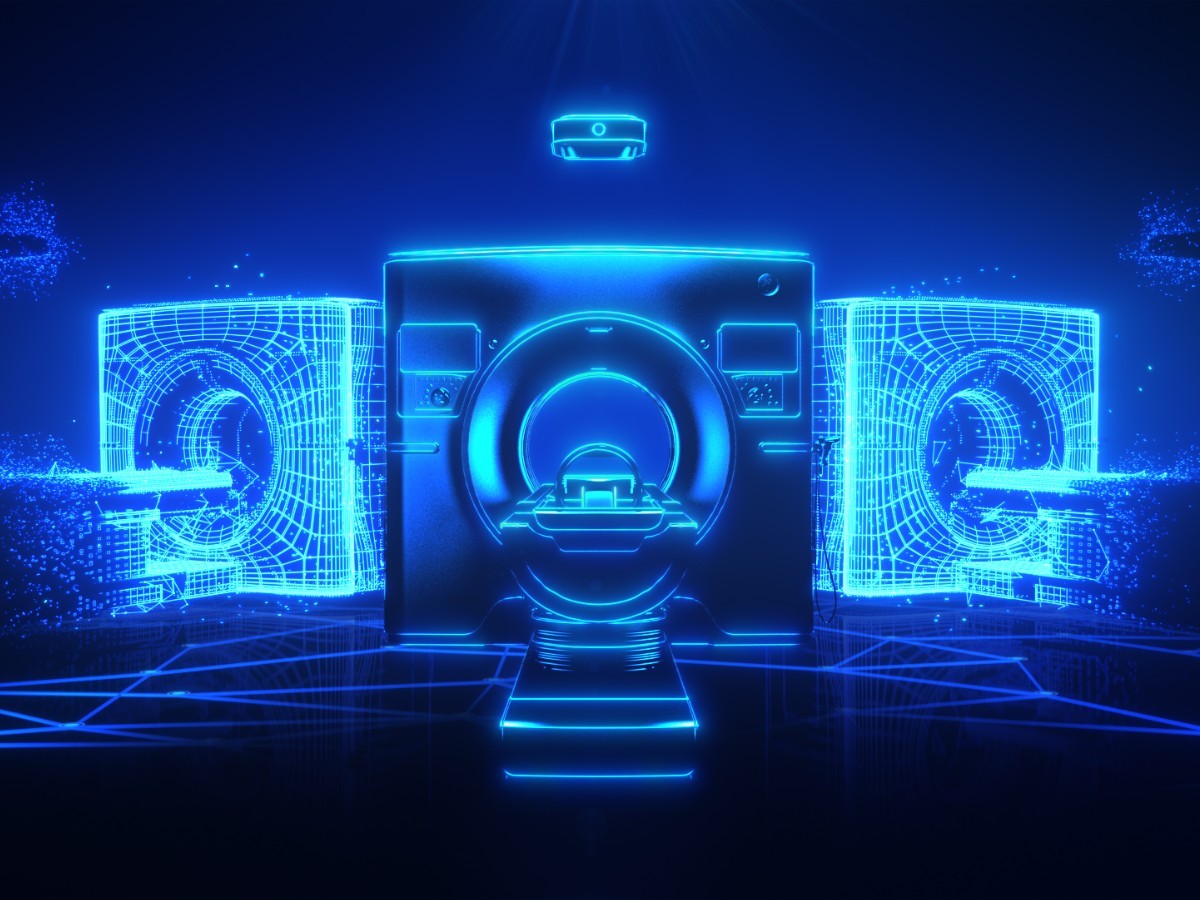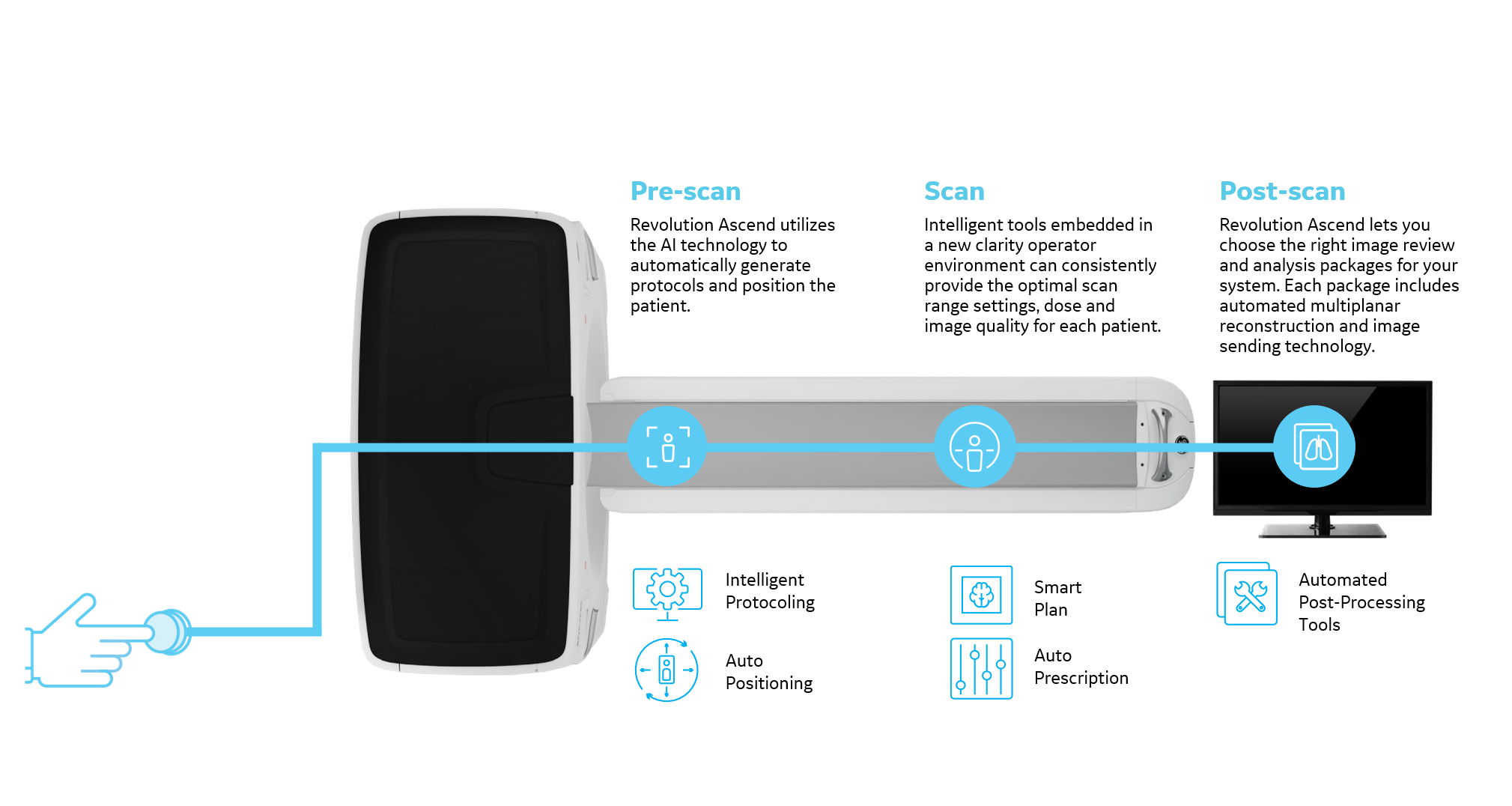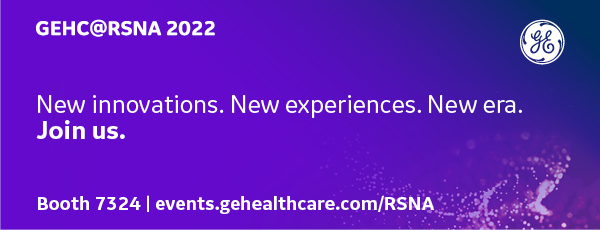Agility is not a word commonly associated with healthcare—until now. The world has witnessed the healthcare community rise to the challenge of a global pandemic. They made changes quickly, adapting to shifts in patient volume and illness severity, as well as taking on new safety protocols that extended exam times amid staffing shortages. While hospital and radiology staff continue to be challenged by the pandemic, providing imaging exams for COVID-19 diagnosis and care, industry partners like GE Healthcare are continuously working to bring them new ways to optimize their stressful workload. With advanced technologies in imaging that are adaptable and sustainable, radiology staff can benefit from new effortless workflow solutions that eliminate clicks and automate tasks to relieve some of their staffing and exam burden.
“We’re helping radiologists and technologists become more efficient,” said Chad Rowland, General Manager Computed Tomography for GE Healthcare. “By rethinking the workflow experience to make it more intuitive and approachable, and adding an artificial intelligence (AI)-based user interface, we’ve created an effortless workflow with intelligent tools that streamline the scanning process from order to report.”
The introduction of effortless workflow solutions in CT, as well as new features and AI based radiology applications, are making a difference in radiologists’ daily lives by offering them more of what they value—time. Delivering on its commitment to provide intelligent efficiencies and build a world that works, GE Healthcare’s new developments in CT technology hardware and software allow clinicians the agility and adaptability they need to meet the changing healthcare needs of today’s patients and remain prepared for what the future may bring.
Efficiencies to Optimize CT Workflow in Speed and Precision
Medical imaging exams with complex scanning protocols and processing requirements are being performed on a regular basis, and the volume of medical imaging data has grown exponentially due to the advances in imaging technology.[1] Optimizing the workflow with solutions to accommodate all the necessary requirements for each and every exam has become more challenging, and radiology departments are looking increase efficiencies and operate with maximum productivity and detailed resource planning in CT.
The availability and adoption of AI applications to aid in workflow optimization is quickly growing, and impacts can be seen in areas such as improvements in exam set up, protocoling and patient positioning. AI based tools are alleviating the time demands on radiology workflows, providing better standardization allowing radiology staff to spend more time on patient care. GE Healthcare’s Revolution™ Ascend CT and Effortless Workflow application uses AI and intuitive design to make the workflow more efficient.
“Having the latest technology innovations help our staff move as fast as they can,” said Gladys Farias, Manager of Imaging Services at West Kendall Baptist Hospital in Miami, Florida. “You have this piece of equipment with all this technology in it, yet it pretty much runs itself.”
“With the Ascend, the [CT] technology is advancing so much that it’s giving more dedicated time to the patient,” said Ricardo Cury, MD, Chairman of Radiology, Baptist Health, Miami, FL. “Having accurate information at point of care is very important. The more automation that we see in gathering that data, its critical to workflow efficiency. By mapping our processes, we can see some of the pain points and if we can automate, we decrease errors. We provide better standardization and less variability.”
In Quimperle, France, hospital staff at L’Hopital de la Villeneuve are enjoying the benefits of the system’s well-planned design that automates many of the typical workflow steps and streamlines the technologist’s workflow.
For each scan order, technologists need to associate a specific protocol on the scanner with the order that was given or the protocol. Oftentimes, the scanner might need additional programming for some of the patients or characteristics, such as heights and weights. Protocols for contrast injectors can also be very complex. Managing the device settings for the different protocols in each exam is time consuming, but also needs to be consistent so that it’s repeatable.
“The interface is very user friendly, very clear, and very easy to use. We enjoy greater visibility on the protocol and on all the series programmed in the protocol,” explained, Jan Castrec, CT Technologist, Centre Hospitalier, L’Hopital de la Villeneuve. “In the exam room, we always use the tablets that are installed [on the system]. On this tablet, you can select the name of your patient with the name of the exam for which the patient is registered.”
The system is also using Auto Prescription: an intelligent feature that automatically adapts scan parameters to patient size and clinical indication. The benefits include providing a dose optimization and a consistent desired image quality across a wide range of patient sizes, eliminating multiple size-based protocols and reducing scan parameter adjustments at scan time. “The equipment has been adapted to make the radiographer’s work easier,” Castrec concluded.
Optimizing Asset Management in CT
Radiology departments are not only challenged with complex imaging protocols and staffing issues, but they are also under pressure to maintain state-of-the-art imaging technology to serve their patient communities. In an environment where the pace of innovation is only getting faster, the challenge of technology obsolescence grows as well. Radiology departments worry that in the not-so-distant future, a new system purchased today won’t be state-of-the-art for very long. With a new CT platform developed by GE Healthcare, the Revolution™ Apex Platform, radiology departments can be “future ready” with built in scalability and upgradability options.
“GE Healthcare is committed to helping our customers become more intelligently efficient with new technologies that can adapt to the changing needs of their environment. Our new modular and scalable CT platform is designed to help our customers achieve success today, but also tomorrow,” said Rowland.
With its ability to scale detector coverage from 4,8, or 16 centimeters of coverage through upgrades, the new CT platform delivers all the technology a customer may need today and can grow when needs change. The platform design has a common look and feel across its fleet, and enables workflow optimization with effortless workflow and protocol standardization built in.
Revolutionizing CT from referral to report
As a leader in the industry, GE Healthcare worked with customers to gain input on their biggest challenges and worked to completely redesign its CT platform with more intuitive features, automated tasks and scalability for the future.
“Radiologists are looking for ways to find efficiencies in their workflow and take on the increased procedure volumes amid shortages in staff,” said Rowland. “The intelligent applications and modular, scalable design are key components of what transforms the CT experience, accurately and automatically personalizing scans for each patient while requiring significantly less effort from the technologist, and reducing the time needed for the sequence from the referral to the radiology report.”
View CT sessions from GE Innovation Theater at RSNA 2022:
- Changing the beat in cardiac care with Revolution™ Apex platform
- Revolutionizing CT experience from referral to report
- Product launch: Revolution™ Apex Platform. Leading CT now and into the future
Not all products or features are available in all geographies. Please check with your local GE Healthcare representative for availability in your country or region.
[1] Tang X. The role of artificial intelligence in medical imaging research. BJR Open. 2019;2(1):20190031. Published 2019 Nov 28. doi:10.1259/bjro.20190031




